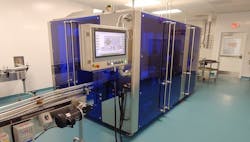Piramal Critical Care (PCC), a division of Piramal Global Pharma, is the third largest producer of inhaled anesthetics and a global player in hospital generics. Its manufacturing facility in Bethlehem, PA produces and packages a variety of inhaled anesthetics — including Sevoflurane, Desflurane and Isoflurane — for use in hospitals, surgical centers and veterinary clinics around the world. PCC also supplies the government health agencies of more than 120 countries.
The company had a “good problem”: over the course of about a decade, PCC had grown its global inhaled anesthetics market share from 3 percent to 30 percent, and required a revamped inspection process capable of keeping pace with this exponential uptick in output.
PCC’s anesthetics are packaged in 100ml and 250ml amber glass bottles, some of which are coated with polyvinyl chloride (PVC). The containers feature either screw caps or spring-loaded, crimped-on closures. PCC had always manually inspected these products on a conventional inspection table after capping. To ensure that the highest standards were maintained, the company incorporated a “double up” method where each container was manually inspected not once but twice.
This double manual inspection, while certainly befitting its high-value, mission-critical products, not only limited throughput rate but, unfortunately, was still prone to missed defects like cracked caps or solution particles. Further, its most prominent customer complaint — partially or fully empty bottles caused by leaks — simply couldn’t be found by the human eye, as this issue typically entails mini-cracks causing slow leaks throughout the supply chain. For that reason, someone inspecting the product immediately after production would, quite simply, have no means of noticing this defect.
“Since our anesthetics are designed to be administered as gas, any small leak causes the product to gradually escape during transport and storage, which is often a months-long process,” said Jim Piper, projects/process engineering manager for Piramal Critical Care.
Automating inspection
PCC knew it was time to go automatic with its inspection. But now, said Piper, a rosy problem born from success became a thornier one.
“As we interviewed various vendors and inquired about a customized inspection unit capable of handling our products, most of them wanted no part of the PVC-coated bottles,” said Piper. “They also expressed hesitation at the containers’ sizes, as well as their amber glass.”
Only one company, Antares Vision, was confident that a machine could be engineered to appropriately inspect each of PCC’s bottle-closure combinations.
PCC sent Antares Vision samples of its various bottles and closures, including ones with cherry-picked defects so that the Antares Vision engineering team could see the specific challenges for themselves. PCC’s request was for an inspection process covering five key parameters: cosmetics of both bottles and their caps/closures; fill level; particles, placement & color confirmation of a collar required on all capped products; and, of course, leakage. Once the varying container sizes were factored in, this meant a total of seven possible packaging combinations — a tall task for any one inspection unit.
Collaborating, designing and ultimately constructing the machine took time — nearly a year, in fact — but was ultimately worth the wait. Eleven months later, Piper and an engineering colleague were in Antares Vision’s headquarters in Brescia, Italy, for a two-week factory acceptance test (FAT). A pair of technicians from Antares Vision’s North American team also participated, so that they could service the machine back in PCC’s Pennsylvania plant whenever necessary.
Customized equipment
Dubbed AV-8304, the unit was a customized version of Antares Vision’s Visual Rotating Inspection family of automatic inspection machines. Among other features, the module includes a vacuum decay container closure integrity system to address PCC’s most pressing, difficult-to-achieve need: exacting leak detection.
The first benefit that struck Piper and his colleague was the interoperability: they were able to change the inspection protocol from one product to another in less than an hour — remarkable considering the disparate, exacting parameters involved. For any inspection machine, pivoting between PCC’s products meant accounting for a product that is 50 percent denser than water in atypically large amber glass bottles (as opposed to more conventional small vials and ampoules) with distinctly different closures.
And once formatted, the unit espoused what for inspection equipment is a crucial combo: speed and accuracy. The unit was able to keep over 100 bottles in motion while maintaining the heightened inspection accuracy demanded; this was a marked, even exponential improvement over manual procedures.
The final hurdle was getting the sizable machine up and running in PCC’s Bethlehem facility. This entailed opening the walls of PCC’s dedicated packaging building, then installing it in-line with the remainder of the packaging infrastructure. To minimize the impact on production, the Antares Vision team worked with the third shift and over weekends to complete the site acceptance test (SAT) and installation operational qualifications (IOQ). A temporary bypass conveyor permitted normal operation of the line during the day.
Fine-tuning results
Each product combination was validated and launched through the 5-in-1 inspection machine. Leak detection, PCC’s greatest need, has been consistently performed, with inspection-related complaints dropping to near zero.
Like any inspection process, fine-tuning is ongoing. For example, PCC is striving to reduce false defects, primarily in the particle detection system, caused by supplier-centric variations in its glass bottles.
“The unit’s bottom dome acts as a lens for the strobe light used to detect reflective particles,” Piper explains, “And at times, what is projected into the bottle exceeds the area of exclusion built into these tests, creating false rejects.”
The fix is a “manual on demand” scenario where line operators can, when deemed necessary, examine all particle and cosmetic rejects to either confirm their unsuitability or allow them to continue to the labeling and packing processes. Piper attests that this intervention is necessary infrequently, and that it has no impact on the larger efficiencies the unit has been introduced to their inspection protocol.
Other servicing needs pertaining to the unit’s uniqueness continue to be assessed and addressed collaboratively between PCC and Antares Vision engineers.
“A customized solution will always have unique issues that pop up. We’ve been able to work very effectively with the Antares Vision team to address any issues, none of which have been anything more than blips.”
The AV-8304’s top speed of 100 bottles per minute is more than twice PCC’s standard operating speeds, meaning the unit does not – and will not for the foreseeable future – constrain product throughput. In fact, it recently reached a milestone of over 5,000,000 PCC bottles handled and inspected.





